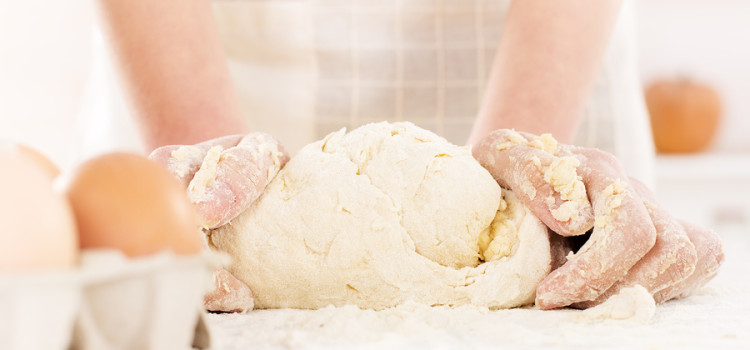

Thinking of starting a gluten-free diet but don’t know where to begin? Wish you could find out if you experience the improved health and wellbeing that so many claim this diet offers, but worried about what you’ll eat?
Then this is a great place to start.
We have compiled a comprehensive guide to gluten-free flours to help you learn the differences between the various flours, the health benefits they provide, and how to use them to cook and bake like a pro.

Why use gluten-free flour?
With so many gluten-free products and prepared mixes crowding the shelves at the grocery store, you may wonder why you should even bother trying to replicate your favorite recipes from scratch.
But the truth is, just because something is gluten-free doesn’t mean it’s healthy. Many gluten-free products are loaded with sugar and preservatives that could have a negative impact on your health. That’s why it’s important to learn how to use these alternative flours to make foods that you KNOW are good as part of your gluten-free diet. It will be more affordable, too!
Use this page as your resource and guide for keeping track of it all. We will be adding to this list every few days so check back often, and please feel free to share this with your friends!
#1- Almond Flour
With their sweet, unassuming taste, ability to lend moistness and structure to basic products, and impressive collection of health benefits, it’s no surprise almonds make a good flour for baking.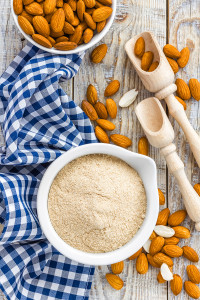
Whether or not you find yourself on a gluten-free diet, almond flour has something to offer. It’s high in fiber, protein, and monounsaturated fats, with a nearly 1:3 ratio of omega-6 to omega-9 fatty acids. If you’re looking to fulfill your recommended daily nutrients, you’ll find vitamins B6 (meeting 88% of daily requirements per cup) and E (166%). Also available in impressive amounts? The essential minerals copper, manganese, calcium, zinc, and magnesium.
Almond flour is a particularly good substitute for wheat flour in recipes because of its moisture and its subtle flavor. If you want to use it for a recipe that calls for kneaded dough, though, it’s a good idea to add structure to the recipe with eggs, psyllium husk, or coconut flour.
On its own, though, almond flour works very well in “quick-bread recipes” such as muffins or pancakes. If you’re on the lookout for an even simpler recipe, just know that almond flour makes delicious breading.
#2- Buckwheat Flour
Sometimes buckwheat gets a bad rap. On its own, buckwheat is too often associated with the kinds of bland foods we eat only because they’re good for us: as in, 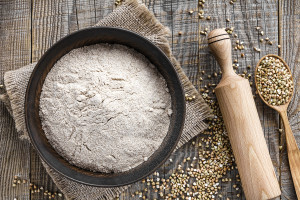 “Would you like some buckwheat in that protein shake?” Some people find buckwheat’s distinctive flavor to be off-putting in high amounts.
“Would you like some buckwheat in that protein shake?” Some people find buckwheat’s distinctive flavor to be off-putting in high amounts.
Two thoughts. First off, buckwheat doesn’t need to be a solo act, and it performs quite well in a recipe. Secondly, it’s a powerful health food for good reason!
Buckwheat is high in fiber and protein, with a great balance of all the essential amino acids. Buckwheat is what you want if you’re looking for a source of B-vitamins and essential minerals (copper, magnesium, manganese, and zinc). The antioxidant flavonoids (rutin and quercetin) in buckwheat are linked to healthy blood flow and other metabolic benefits.
As for preparation, where to start? Buckwheat can be sold either unroasted or roasted (the latter also known as “kasha”). While Eastern Europeans make a traditional dish from roasted whole buckwheat groats, in the United States buckwheat flour is best known as a healthy pancake ingredient.
As with all wheat flour substitutes, the best thing you can do when trying to switch out the ingredients of your favorite gluten-containing recipes is to find new recipes. Gluten-free chefs have spent years figuring out the how much of which ingredients are necessary to a gluten-free recipe, so you may save a lot of time and frustration by starting there. If you do choose to substitute buckwheat flour for wheat flour in your own leavened baked goods recipe (including breads), though, try to create a flour mixture with 50% buckwheat. Many bakers have found that buckwheat flour works well with brown rice flour when you’re preparing that kind of blend.
We may use buckwheat as a grain, but it’s actually a tiny seed known as a “pseudograin” and like most other seeds, buckwheat is best stored in the refrigerator.
#3- Amaranth Flour
Like buckwheat, amaranth is a pseudograin. It has an impressive heritage, with a history going back 8,000 years. 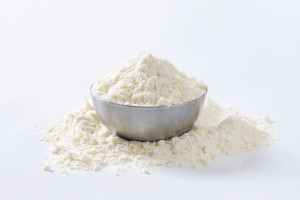 The Aztecs valued amaranth both as a food and for use in religious ceremonies—leading some to call it the “golden grain of the gods.”
The Aztecs valued amaranth both as a food and for use in religious ceremonies—leading some to call it the “golden grain of the gods.”
Amaranth is still valued today for its health benefits. It has all the essential amino acids, including lysine (which is often lacking in other grains). Amaranth is high in fiber (12 grams per cup) and protein (26 grams per cup). It’s also a good place to look for your B-vitamins (B2, B5, and B6) and your essential minerals (calcium, iron, magnesium, manganese, copper, selenium, and zinc).
In terms of not only reaching greater wellness but also preventing problems down the road, amaranth is high in phytosterols. Phytosterols have been shown to support prevention and management of metabolic disease, so it’s not a bad idea to start working a little amaranth into your regular diet.
As a substitute for wheat flour in bread, aim for a flour mixture that includes no more than 25% amaranth. For other baked goods, you can include up to 30% amaranth. If you’re making a non-rising bread (such as quick-bread or biscuits), you can forget about the flour mixture and use amaranth flour on its own.
Amaranth flour is also an easy ingredient for thickening sauces or for breading. It has a nutty, earthy flavor, and it adds a somewhat crunchy texture to your recipes. To try something different, prepare popped amaranth for breakfast cereal.
- Amaranth is a pseudograin that the Aztecs were cultivating 8000 years ago.
- Loaded with essential amino acids, fiber, protein, B-vitamins and essential minerals.
- High in phytosterols- which help prevent and manage metabolic disease.
- Has a Nutty, Earthy flavor that works well in sauces and breading- can be 25-30% of the flour mix in your recipes.
#4- Chia Flour
When you were a kid, you might have been introduced to chia seeds through the Chia Pet*, that great experiment in growing funny green “hair” on terra cotta figurines.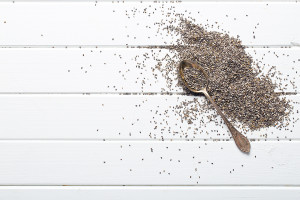 To the ancient Mayans and Aztecs, however, “chia” meant something very different. The chia seed was an important staple in their diets—the word “chia” comes from the Mayan word for “strength.” That’s no surprise, since the Aztecs counted on chia seeds for increased energy and stamina, and today’s athletes and runners call chia seeds a superfood for strength and endurance.
To the ancient Mayans and Aztecs, however, “chia” meant something very different. The chia seed was an important staple in their diets—the word “chia” comes from the Mayan word for “strength.” That’s no surprise, since the Aztecs counted on chia seeds for increased energy and stamina, and today’s athletes and runners call chia seeds a superfood for strength and endurance.
Chia flour is easy on the body, with anti-inflammatory properties and low allergenicity. Better yet, it’s easily broken down and digested (which is nothing to sneeze at, considering the amount of dense, processed food we usually eat).
Low in available carbohydrates and high in fiber and protein, chia flour is also a good source of vitamins (B1 and B3) and essential minerals (calcium, iron, magnesium, selenium, and zinc). In fact, chia flour provides 500% more calcium than milk does, so for lactose-intolerant or dairy-avoiding folks, this is a good place to get what your bones and blood need to stay strong and healthy.
Chia flour can be used as a direct substitute for wheat flour, which is a rare short-cut not shared by most gluten-free flours. Chia flour on its own works best for doughs that should be thick or gummy. If you’re in need of a more solid mixture (e.g., for cookie dough), you can make an easy flour mixture with 1 part chia flour to 3 parts other gluten-free flours.
The easiest use for chia flour is as a simple thickening agent, but it can also serve—surprisingly—as an egg substitute. To substitute for eggs in vegan recipes, mix two tablespoons of chia flour with half a cup of water. Let it sit for 30 minutes or grind the mixture for 30 seconds, and what you’re left with can stand in for a single egg, as is or strained to be seed-free.
- Chia Seed is a super food that the Mayans and Aztecs (and modern day athletes) used to boost strength and stamina
- Anti-Inflamitory properties and low-allergenicity.
- Low in carbohydrates and high in protein, B-vitamins, essential minerals
- 500% more Calcium than milk- great for lactose intolerance
- An egg substitute! Mix 2 Tablespoons of Chia Flour and ½ cup of water- let sit for ½ hour then grind for 30 seconds = 1 vegan “egg”.
*Chia Pet is a registered trademark of Joseph Enterprises Inc., San Francisco, CA.
#5- Chickpea Flour ~ Cherished, Nutritious, Flexible
Chickpea flour is considered a staple in Indian cuisine. It comes in two different varieties—besan is made from unroasted chickpeas, and chana from roasted.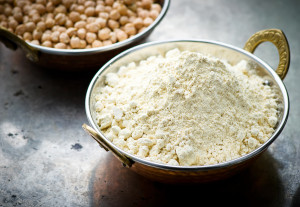 Whichever you choose, you’re bound to benefit from the fiber, protein, vitamins, and minerals abundant in the chickpea.
Whichever you choose, you’re bound to benefit from the fiber, protein, vitamins, and minerals abundant in the chickpea.
Chickpea flour is a good source of protein, yielding nearly 21 grams per cup or 92 grams. A cup of chickpea flour also has 6 grams of total fat, mostly unsaturated, and 10 grams of fiber, both soluble and insoluble. If you’re looking to balance your diet and rely a little less heavily on multivitamin supplements, know that chickpea flour is a good place to look for folate, vitamins B-1 and B-6, iron, and magnesium. Chickpea flour is also a good source for the antioxidant minerals manganese, copper, and zinc.
Despite being starchy, chickpea products have been found in clinical research to actually be supportive of a healthy metabolism, including in diabetics.
Chickpea flour has a very subtle flavor, which allows it to work without being overpowering in both savory and sweet dishes. While a main course, egg-substitute dish, or pudding-like dessert can rely on chickpea flour by itself, recipes that require leavening—cakes and breads, for example—do better with a mix of chickpea flour, sorghum flour, and sweet brown rice flour.
According to experts, you can substitute ⅞ cup / 80½ g of chickpea flour for every cup (120 g) of wheat flour. If you prefer a flour mix, use up to 25% chickpea flour combined with other flours for optimal breads, crackers, or crusts. One much-loved use of chickpea flour is to make it into thin crêpes (called cheela in Hindi) and use it to scoop and enjoy toppings and fillings such as vegetables, lentils, and yogurt.
It’s important to note that chickpea flour may absorb more or less fluid than other flours do, and you may have to adjust your recipe accordingly. For rising-dough recipes such as breads or cakes, blend with other flours (see above), and/or add xanthan or guar gum or flax or chia seed to fill in for the sticky property of gluten.
#6- Coconut Flour
Like coconut oil and coconut milk and all things coconut-related, coconut flour is having a moment of fame, as coconut products are being embraced in western countries like never before. Part of coconut flour’s appeal is that it offers an alternative for gluten-free folks, and another part is the observation that coconuts may offer health benefits not previously appreciated.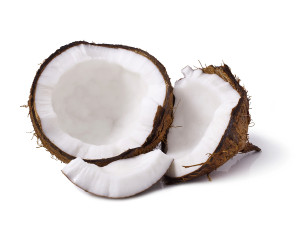
Coconut flour offers 16 grams of protein per cup, and that same cup holds 40 grams of fiber with only 24 grams of available carbohydrates—given that the average portion size works out to be about 2 tablespoons, which means it contributes virtually none. That’s a very attractive option for people who have conditions sensitive to simple sugars (such as diabetes and hypertriglyceridemia). It’s also worth noting that the fiber offered is largely insoluble—that means it’s the kind of fiber which will add bulk to your stool, allow you to feel full, help prevent constipation, and support the health of your colon.
While most of the fat in coconut flour is saturated, the specific fatty acids and “medium-chain triglycerides” have been suggested in research to improve the metabolism while allowing for easy digestion.
Other nutrients present in high amounts in coconut flour include vitamin B6 and the essential minerals iron, magnesium, selenium, zinc, and particularly copper and manganese.
If you choose to make a flour mixture with coconut flour, try to make it up to 25% coconut flour before adding the others. Coconut flour has a very light and dry consistency, so the equivalent of 1 cup of wheat flour would be about ⅓ to ½ of a cup of coconut flour. In order to get the correct measurement of coconut flour, make sure that you aren’t packing down the flour into your measuring cup.
More importantly, it is important to note that coconut absorbs and therefore needs more liquid than do other flours. For example, if a wheat flour recipe calls for a certain amount of it milk or water, know that coconut flour requires about double that amount. Since you won’t have the benefit of gluten to help with binding your dough in baked goods, try to compensate with sticky sweeteners such as honey or maple syrup. If you’re substituting for egg (in, say, a gluten-free and vegan recipe), you can get to an egg-like consistency by mixing flax, chia, guar gum, or xanthan gum with liquid.
When you’re looking to cook, coconut flour is a great ingredient for sauces and smoothies. It makes for a thicker consistency, like many gluten-free flours would, but has the added treat of a subtly sweet and exotic taste.
#7- Flaxseed Flour
Flaxseed flour is gluten-free and low in allergenicity, so you’d be hard-pressed to find someone who can’t enjoy it. Flaxseed flour (also known as flaxseed meal) 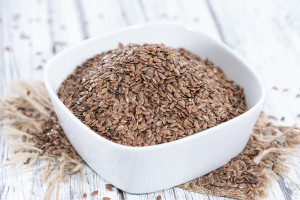 is made from ground whole seeds, making it much easier to digest than the seed would be otherwise. Most of the dietary benefits of flax are found in the seeds, so when you eat flaxseed flour you have the advantage of eating only the healthiest part of the plant.
is made from ground whole seeds, making it much easier to digest than the seed would be otherwise. Most of the dietary benefits of flax are found in the seeds, so when you eat flaxseed flour you have the advantage of eating only the healthiest part of the plant.
Flaxseeds are a rich source of fiber, with 30 grams in each cup. It provides omega-6 and omega-3 fatty acids as well (just 1 tablespoon fulfills the daily recommended amount), which are incorporated into cell membranes, eye tissue, nerves, and chemical messengers. The high omega-3 content is anti-inflammatory, which may protect against metabolic diseases.
In addition, flaxseed flour is high in vitamins B1 (167% of the daily requirement per cup) and B6 (41%) and the antioxidant minerals copper, manganese, selenium, and zinc (52-154% of daily requirements). Flaxseed flour offers calcium (29%) and magnesium (137%), and it’s also rich in phytochemicals called lignans. Lignans are antioxidants, which may protect your cells from damage.
One option for incorporating flaxseed flour into your diet is to purchase it pre-ground. However, a better option is to buy the seeds whole and then ground them yourself using a coffee or spice grinder in order to protect the fatty acids from spoiling. Flax has a rich oil content that causes it to spoil relatively quickly, but you can get past this by refrigerating or freezing your flaxseed flour.
Flaxseeds are a subtle, easy way to add nutrition to your day. You can add flaxseed flour to your muffins, cookie, and bread recipes, and throw some in with your breakfast smoothie. To add it to your baked goods, just replace 15% of other flours with flaxseed flour and use 25% more yeast than the recipes calls for.
For vegans, flaxseed flour can also serve as a substitute for eggs. Simply mix one part flaxseed flour with three parts water (or other liquid). Though this works well with recipes that call for eggs, it’s not recommended for recipes that require eggs, such as yeast breads that are egg-based.
For people with thyroid conditions, note that flaxseed does contain “goitrogenic” compounds, so it is best to limit intake and/or avoid consuming it raw.
#8- Rice Flour
Rice flour is a good place to look for protein (a cup holds 11 grams) and fiber (7 grams, both soluble and insoluble). If you’re able to make whole brown rice flour a consistent part of your diet, you might begin to notice an improvement in regularity and possibly even metabolic markers such as blood fats.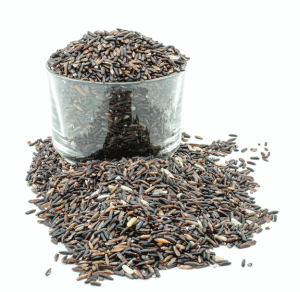
B-vitamins in rice flour include B1, B3, B5, and B6, meeting 50-90% of your daily requirements per cup. Rice flour is also a source of essential minerals, such as copper, magnesium, and selenium. You can meet 23-76% of your daily needs in zinc, and a whopping 350% of your needs in manganese.
If you’d like to replace wheat flour in a baked goods recipe with rice flour, try to use a recipe that specifically calls for rice flour (these recipes are more common in gluten-free cookbooks and online). While other gluten-free flours often allow you to create flour mixes that stand in for wheat flours in a wheat recipe, rice flour very often needs to be part of a homemade flour mix, and it would take some experimentation to reach the desired consistency in your baking.
Cooking, as opposed to baking, is a much simpler process when working with rice flour. Rice flour serves as a thickener for soups, sauces, and gravies in the same way that wheat flour does. Just make a roux from oil, onion, and rice flour before mixing in the liquid and simmering. To make a slurry, add 1 part rice flour to four parts water and mix until the clumps are gone. Add one cup of liquid from your soup or sauce, and mix before adding your mixture to the original pot.
To add a crispy layer to your vegetables, fish, poultry, tofu, or meat, simply coat them with rice flour before sautéing or roasting.
#9- Quinoa Flour
Quinoa has become increasingly popular in the United States in recent years, but for much of the world it has been a staple for centuries. 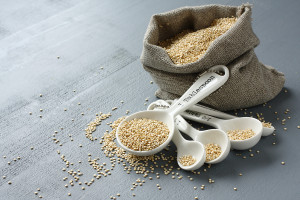 Many different varieties of quinoa are available, but in western cultures the most popular variety is white—this is also the easiest type for making flour. As you shop, keep in mind that the darker grains are richer in nutrients. It’s less common to see flour made of these darker varieties, but you can grind them into your own homemade gluten-free flour using a coffee grinder, high-speed chopper, or food-processor.
Many different varieties of quinoa are available, but in western cultures the most popular variety is white—this is also the easiest type for making flour. As you shop, keep in mind that the darker grains are richer in nutrients. It’s less common to see flour made of these darker varieties, but you can grind them into your own homemade gluten-free flour using a coffee grinder, high-speed chopper, or food-processor.
Quinoa flour is valued for its anti-inflammatory phytonutrients, and for the high quality of its 16 grams of protein per cup. Quinoa flour is a good source of fiber and omega-3 fatty acids, and meets a third or more of your daily needs for key essential minerals and vitamins. For example, quinoa flour has enough folate and B-vitamins (B1, B2, and B6) to meet 33-52% of your daily recommended amounts. That’s in addition to quinoa flour’s offerings in copper, magnesium, and manganese (meeting at least 70% of the requirements), as well as iron and zinc (29% and 44%, respectively).
Unlike some subtler gluten-free flours, quinoa flour has a noticeable flavor, especially if the grains were not rinsed or toasted before grinding. Some describe it as nutty and some describe it as slightly bitter or sour, but it’s recommended that you experiment with it in your favorite dishes and baked goods in order to find what works best for you.
In order to replace the wheat flour in most recipes, create a flour mix and only use 50% quinoa flour for leavened products such as breads and cakes. If you’re looking to replace the wheat flour in recipes for unleavened cookies and crackers, feel free to completely replace all of the wheat flour with quinoa flour. Because of its unique flavor, quinoa flour is especially suited to English muffins and bread.
The consistency of quinoa flour is fairly light compared to other flours, so it works quite well in pastries such as pie crusts and cookies. If you’re looking to get a fluffier texture, just add eggs or an egg replacer such as aquafaba. The best flavors to pair with quinoa flour are nuts, fruits, and herbs such as rosemary. You can also pair it with spices, such as cinnamon, coriander, cardamom, and cumin.
#10- Bean & Lentil Flour
Beans are a great place to look for dietary fiber (13 grams per cup) and protein (over 30%), while being low in sodium and fat. Bean and lentil flours are packed with nutritional value, from phytochemicals yielding antioxidants to essential minerals such as copper, manganese, iron, magnesium, and zinc (56-116% of daily requirements per cup) to B-vitamins, particularly B1, B5, B6, and folate (up to 133% of requirements).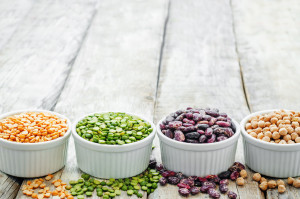
When you start incorporating bean and lentil flours into your diet, you’ll see a marked change in your overall health—and you might not feel so hungry anymore. Bean and lentil flours have been shown to decrease blood glucose and insulin spikes, protecting you from sudden shifts in how much energy you feel you have. They help to control your appetite, allowing you to feel fuller for longer. Finally, bean and lentil flours improve fat storage in tissues, gut health, cholesterol, and insulin sensitivity.
You can use up to 25% bean flour in your gluten-free mix for baking. Examples of use:
- Black bean flour works well in baking mixes for chocolate cakes and brownies, but you can add a small amount to bread recipes for a darker, whole-wheat look.
- Green pea flour can lower the fat content of guacamole and add extra nutrition—just add it to your guacamole as you mix the other ingredients. Like black bean flour, it also works in chocolate cakes and brownies.
- Mung bean flour is almost pliable and stretchable like regular gluten-containing flour, and thus can be added at a higher proportion for such things as pie and pizza crusts.
When used as a thickener in soups and stews, bean flours can be used on their own. An additional benefit is that it can reduce the fat content while lending a desirable consistency.
- White bean flour’s subtle flavor makes it particularly ideal for sauces and gravies. Use white bean flour to thicken soups and upgrade the nutritional value, all without interfering with the flavors you’ve already established.
#11- Cornmeal and Cornstarch
The first thing to know about cornmeal is that its name often gets confused and leads to incorrect online searches. What you might consider to be “corn flour” is actually called cornmeal, which is basically dried and ground corn. Cornstarch, on the other hand, comes from the endosperm of the corn. Where cornmeal retains the flavor of corn, cornstarch has a more neutral flavor.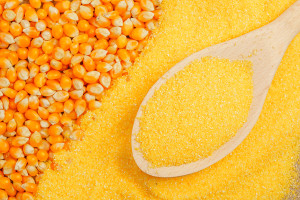
Cornmeal—high in protein, fiber, vitamins, and minerals—is an excellent choice for health-conscious folks looking for an alternative to glutinous flours. It digests slowly, which allows you to feel fuller for a longer part of your day. Not only will feeling full help you to avoid the temptation of fatty foods, but as you go about your tasks the cornmeal will continue to supply your body with a steady stream of energy.
A single cup of cornmeal has over 10 grams of protein, in addition to 8.5 grams of fiber. That makes up 34% of the daily fiber intake recommended for women, and 22% of what’s recommended for men. That same cup fulfills at least 25% of the requirements for iron, magnesium, selenium, and zinc. Cornmeal provides almost half of what you need each day in vitamins B1, B2, B3, and B6.
Because of its consistency, cornmeal works well as a thickener if used correctly. That means blending one part cornmeal with two parts cold liquid, and only then stirring the mixture into whatever sauce needs thickening. This is because cornmeal forms lumps if it’s added straight to a hot liquid.
Cornmeal comes in two consistencies, so you should pay attention to what will fulfill your needs. Coarser cornmeal will offer a crunchier texture (say, as breadcrumbs for chicken or eggplant parmesan), but you’ll want a finely ground cornmeal for any baked goods.
The most traditional use of cornmeal is in special breads, such as cornbread or tortillas, though it’s also known as the central ingredient in grits and mush. Cornbread makes a delicious side for home-cooked meals such as chili or soup, and tortillas allow even gluten-free diners to enjoy Mexican cuisine.
Cornstarch, however, has its own properties. It’s set apart from many other gluten-free flours in that it has almost no essential vitamins or minerals, and it is not a good source of protein.
Cornstarch can be used to up your calorie intake, but so can other flours with more to offer in the vitamin department.
Some find that cornstarch is helpful in managing blood sugar in those with diabetes and glycogen storage disease. This is because uncooked cornstarch digests very slowly, supplying a steady stream of energy that can prevent low blood sugar.
If you’re looking to take in more calories without altering the flavor of your dishes, you might consider mixing a tablespoon of cornstarch with your yogurt, pudding, mashed potatoes, or hot cereal. This will slightly thicken your foods, while adding 30 calories to the menu.
Cornstarch can be used as a thickener to gravies, pie fillings, puddings, custards, cake fillings, and more. It has more power than flour does, and once you add it to your liquid batter it will expand to about ten times its size as it absorbs the liquid. While you can certainly bring this close to a boil, avoid allowing your mixture to fully boil and be sure not to stir too long or too hard. This will cause it to deflate, changing the thickness back to what it was before you added the cornstarch.
As cornstarch cools, it sets. This is especially helpful with desserts, as you want your puddings and pie fillings to hold a shape without being affected by any outside flavors. Though it’s certainly possible to use cornstarch in savory dishes, it’s far more commonly found in desserts.
#12- Soy Flour
For a lot of people, soy is seen as a sacrifice. If you can’t or won’t eat meat, you eat soy. If you can’t or won’t drink milk, you drink soy. As time goes on, though, and more and more Americans are introduced to foods that weren’t on the dining table fifty years ago, we’re starting to see just what it is that soy has to offer.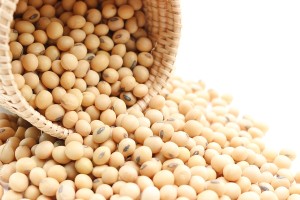
Soy is very high in protein, making up almost 35% of its total weight. It’s also high in isoflavones, which are associated with a reduced risk of heart disease, cancer, osteoporosis, and menopausal symptoms. Substituting wheat flour for soy flour lets you benefit from the vitamins in soy flour: vitamin K, vitamin B1, vitamin B2, and folate. Keep in mind, that’s in addition to the essential minerals copper, magnesium, potassium, and zinc (accounting for 40% of your daily recommended amounts in a single cup).
One way to make sure you’re getting more soy in your life is to use it as a substitute for wheat flour. Just make a flour mix, and let soy flour make up 30% of it. Though the preparation for baking is otherwise unaltered, you do have to keep a close eye on your baking when it’s in the oven—baked goods made with soy flour do tend to brown faster than those with other flours. Another option is just to follow a recipe intended for soy flour.
Some use soy flour in order to condition their dough before baking bread. This not only adds nutrition, but also creates a higher and lighter loaf after baking. To use soy as a conditioner, just add one tablespoon of soy flour for every cup of flour called for in the recipe (if you’re following a gluten-free diet, you could make gluten-free flour mixes for the cups called for and then add soy flour as a conditioner).
Like most gluten-free flours, soy flour works as a thickening agent when cooking. It adds protein and fiber to your dish, while bringing it to the desired consistency.
#13- Tapioca Flour
Tapioca is for more than just the pudding. Putting aside its great taste, tapioca is a good alternative to wheat flour for reasons that go beyond gluten sensitivity.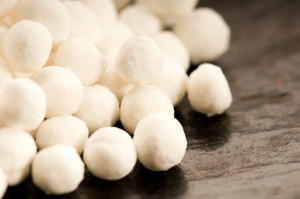 Tapioca flour has very little protein or fat, so it’s 80% carbohydrates with almost no fiber. If you’re looking for vitamins and minerals, tapioca flour isn’t a good source. At best, you can find some brands of tapioca flour that include a little iron, meeting 8% of your daily requirements per cup.
Tapioca flour has very little protein or fat, so it’s 80% carbohydrates with almost no fiber. If you’re looking for vitamins and minerals, tapioca flour isn’t a good source. At best, you can find some brands of tapioca flour that include a little iron, meeting 8% of your daily requirements per cup.
When baking, don’t use tapioca flour on its own. Instead, include it as just 30% of a flour mix. Tapioca flour is not known for its use in baked goods, but it does add crispness to crusts and chewiness to baked goods when added to a recipe with a different flour as the base. While you’re using tapioca flour for your crust, go ahead and use it for the pie filling as well. Tapioca flour has a neutral flavor that does well when added to fillings, custards, and puddings.
In general, tapioca flour performs best in cooking as opposed to baking. It gelatinizes at low temperatures, doesn’t discolor, and has neither noticeable taste nor smell. Those three traits make it an ideal sauce thickener, leaving the finished project translucent in appearance and smooth in texture.
When compared to other gluten-free flours, tapioca flour can’t be cooked for as long as others can. In order to reach the desired color and consistency without ruining the dish over the long cooking process, it’s best to wait until the very end of your cooking before thickening the sauce.
Finally, tapioca sauce has one hidden advantage: it can serve as a cornstarch substitute. To do so, just use two tablespoons of tapioca flour for each tablespoon of cornstarch called for in the recipe. (https://georgetownvoice.com/)
#14- Sorghum Flour
Sorghum has been an important crop in Africa for over 4,000 years. It came over to the US a few hundred years ago, but might not be well-known to readers outside of the American South. Way back when, people in the South used sorghum as a staple for sweetening—it was everywhere, and it was cheap. 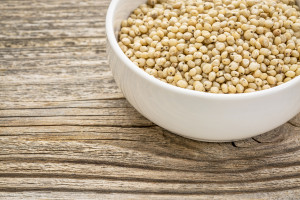 The tradition continues today in some communities, but as sweeteners such as sugar and honey have become more affordable we’ve come to love sorghum for very different reasons.
The tradition continues today in some communities, but as sweeteners such as sugar and honey have become more affordable we’ve come to love sorghum for very different reasons.
Sweetness aside, sorghum is good for you. It’s high in protein with a full 10 grams per cup, and offers all the essential amino acids. You can get 8 grams of fiber in each cup of sorghum flour, and catch up on 30% of your daily requirements in B-vitamins. Sorghum flour has a very high mineral content, offering 85% of your needs in manganese and 21-48% of your needs in iron, copper, magnesium, zinc, and selenium.
Sorghum flour is also low in allergenicity: if you’re hosting a big group and aren’t sure of everyone’s allergies, you can count on sorghum not being a troublemaker.
The sweet and nutty flavor that made sorghum so effective as a sweetener makes it just as delicious as a gluten-free flour. It’s especially enticing in desserts, such as cookies, cakes, and brownies. If you’re going to use it for those, though, create a flour mix that is ½ to ⅞ sorghum flour.
For baking, consider sorghum as a way to add volume and texture. When putting together your flour mix, just add the sorghum flour to a fatty flour (like coconut flour) or a starchy flour (like tapioca). Sorghum flour should make up about 20% of the total flour mix you use in baking bread.
#15- Teff Flour
Teff has only recently cropped up in western health food stores, usually in the form of teff flour for those seeking gluten-free alternatives to wheat flour. But in Ethiopia, it’s been an important staple for thousands of years. Ethiopian cuisine includes a spongy bread—made of teff flour—that mops up spicy dishes with its own subtly sour taste. It also includes a homemade beer made from teff. It’s an important grain over there, and there’s no reason its health benefits can’t be enjoyed around the world.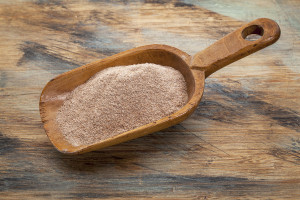
Because teff flour has a much greater percentage of bran and germ than other flours, it’s an excellent source of dietary fiber. When eaten consistently, this makes it easier to stay regular and improve colon health. About a third of the carbohydrates from teff are resistant starches, which not only benefit colon health but also help with weight control and blood sugar management.
There is significantly more calcium in teff than in any other grain, providing 320 mg in each cup. Just one cup of teff meets 60% of your daily requirements for iron, and 13% of the total weight is protein. Though many of your guests may not have heard of teff before, it’s unlikely that anyone will be allergic to it.
For baking, teff flour makes a good yeasted bread with a crispy crust. It works well with cakes, pancakes, and scones, and you have a choice between using teff flour alone or making teff flour just one part of your flour mix. If you do choose to go that route, have teff flour account for about 25% of your gluten-free flour mix. Adding teff flour to baked goods recipes ensures added nutritional benefits.
Teff flour can also be used as a thickener in soups and stews, or just as a means of adding nutritional value. In order to add it, you have two choices. One option is to cook your dish first, and add teff flour to your soup or stew for the final ten minutes of cooking. Another option is to add your teff flour from the beginning, and to cook it as a part of the soup or stew for the entire time.
#16- Lupin Flour
Like beans and peanuts, lupin is a legume. What that means is that its flour is very low in carbohydrates and fat. 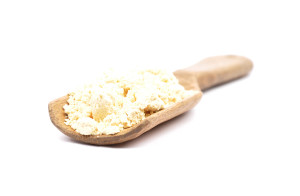 If you’re looking for a protein-rich, low-fat alternative to wheat flour, lupin flour may be for you. Yielding 40% protein and more than 35% dietary fiber, it gives you much-needed energy and maintains a healthy digestive system.
If you’re looking for a protein-rich, low-fat alternative to wheat flour, lupin flour may be for you. Yielding 40% protein and more than 35% dietary fiber, it gives you much-needed energy and maintains a healthy digestive system.
Lupin is gluten-free, which is a definite plus for those with celiac disease or non-celiac gluten sensitivity. That said, it’s from the same family as peanuts. Some people may be allergic to it, particularly those who are already aware of a peanut allergy.
If you’re clear to enjoy it without an allergic reaction, lupin flour has a lot to offer, It’s high in B-vitamins (particularly B1 and B6), and meets 25-80% of your daily folate requirements. Lupin flour is a good source for essential minerals such as iron and potassium (meeting 20% of daily needs), and it’s especially rich in manganese, manganese, and zinc (meeting 53-119% of requirements!).
If you’re baking and wish to make a flour mix, use up to 20% lupin flour. You can mix it with wheat flours to make your bread more nutritious, or stick to gluten-free flours if you’re looking to avoid gluten. By mixing lupin flour with other flours, you’re balancing out the amino acid profile and making your bread a more complete food.
#17- Pumpkin Seed Flour
Pumpkin, usually saved for fall and winter seasonal treats, has been showing up in stores and restaurants earlier and earlier over the last few years. Partly this has to do with its unique, sweet and spicy taste, but there’s also a strong case to be made for the nutritional benefits of making pumpkin a year-round part of your diet.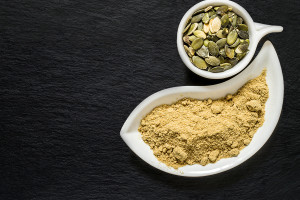
Pumpkin seed flour is one of many healthy, gluten-free alternatives to wheat flour, but it has the added benefit of a subtly sweet flavor. The nutritional value of pumpkin seed flour has a lot to do with its 30% total weight in protein, as well as its balance of all the essential amino acids. Pumpkin seed flour is low in total and available carbohydrates, with 6% fiber per total weight.
There is a nearly 1:1 ratio of omega-6 to omega-9 fatty acids in pumpkin seed flour. It’s rich in B-vitamins, with B1 and B3 respectively meeting 32% and 46% of daily needs per cup of pumpkin seed flour. This is in addition to B2, B5, choline, and folate. Pumpkin seed flour meets almost 20% of the daily recommended amount of vitamin E, and it’s quite rich in essential minerals. While 63% of your daily requirement for iron is met in a cup of pumpkin seed flour, with copper, magnesium, and manganese you can fulfill about 200-300% of your needs.
A strong case can be made for the delicious flavor of pumpkin seed flour, which makes for a mildly nutty and sweet alternative to wheat flour. For those who are allergic to nuts, pumpkin seed flour makes a good alternative for the subtly sweet flavor of almond flour. It works best in crumbles and breads, but can be enjoyed in cookies, cakes, muffins, and pies as well.
When you’re using pumpkin seed in a recipe with baking soda, sometimes tiny green specks appear in your baked goods. You should know that this is just a result of the chemical reaction between these two ingredients, and it’s completely safe to eat. Another thing to note is that the oils in pumpkin seeds cause the flour to go rancid rather quickly. To avoid this you can either make your flour only as needed, or store your floor in the refrigerator or freezer.
#18- Potato Starch and Potato Flour
To start off, let’s be clear. Though both are gluten-free alternatives to wheat flour, there is a difference between potato starch and potato flour.
Potato starch is a “resistant” starch. That means that despite its high glycemic index, it can support improve insulin sensitivity, gut health, cholesterol panel, mineral absorption, and your overall metabolism. 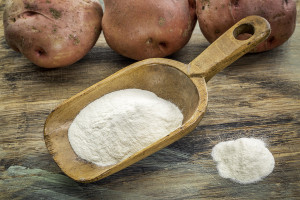 It can also lower the frequency of blood insulin spikes that occur after meals, and support fat storage in fat cells. Similar in texture to cornstarch, potato starch is a very fine white powder starch. Made from the dried starch of peeled potatoes, potato starch has no potato flavor and so it works in both sweet and savory recipes.
It can also lower the frequency of blood insulin spikes that occur after meals, and support fat storage in fat cells. Similar in texture to cornstarch, potato starch is a very fine white powder starch. Made from the dried starch of peeled potatoes, potato starch has no potato flavor and so it works in both sweet and savory recipes.
When you’re cooking with potato starch, it’s important to note that potato starch will gelatinize at relatively low temperatures. That said, it can tolerate higher temperatures than cornstarch can when used as a thickener for soups and sauces. The result is a glossier and more translucent sauce, with a silkier consistency. Once gelatinized, you can use potato starch to add moistness to your baked goods. Other uses include puddings, custards, and pie fillings. Because of the neutral flavor of potato starch, results are usually more consistent than those of potato flour.
Potato flour is made from whole potatoes, including the peel, after they’ve been dried and ground. The resulting flour is heavy, and it carries with it a definite potato flavor. Potato flour yields 9 grams of fiber per cup, and 11 grams of protein. It’s high in B-vitamins (33-40% of daily requirements in B1 and B3 per cup), and able to meet 95% of your daily requirement of vitamin B6 in just one cup. Potato flour is a good source of copper manganese, magnesium, and potassium, as well as vitamin C.
When it comes to baking, potato flour works well in many recipes but it best known for its use in waffle and pancake recipes. It holds water well, contributing to a moist yeast bread that will last for longer than other breads. If you don’t want to commit to a full potato flour bread, adding just a teaspoon of potato flour to an otherwise non-potato flour bread dough will create a moist crumb.
Potato flour can also be used as a thickener, an extender, a binder, or as breading. As a thickener potato flour adds body to stews, soups, broths, and gravies, and as a breading your potato flour will add a crunchy crust to your finished dish whether used alone or mixed with cornmeal.
#19- Sunflower Seed Flour
Sunflower seeds are much loved as an on-the-go snack, and sunflower seed flour allows us to enjoy both the familiar taste of sunflower seeds and the nutritional value they can add to our lives—not just from a bag, but baked into our favorite recipes.
Sunflower seed flour is an excellent source of protein, with a good balance of all essential amino acids. 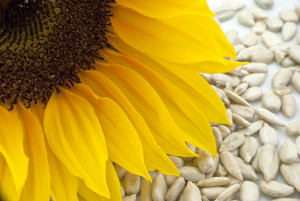 It’s low in total and available carbohydrates, with more than 8% fiber per total weight. Sunflower seed flour maintains a nearly 1:1 ratio of omega-6 to omega-9 fatty acids, and it’s rich in fiber and antioxidants (for example, one cup of sunflower seed flour meets over 300% of your daily requirement of vitamin E.
It’s low in total and available carbohydrates, with more than 8% fiber per total weight. Sunflower seed flour maintains a nearly 1:1 ratio of omega-6 to omega-9 fatty acids, and it’s rich in fiber and antioxidants (for example, one cup of sunflower seed flour meets over 300% of your daily requirement of vitamin E.
With just one cup of sunflower seed flour, you can meet 83-188% of your daily needs in vitamins B1, B3, and B6, in addition to B2 and folate (about 80%). Sunflower seed flour is high in iron (41%) and essential minerals, meeting 88-280% of your needs in copper, selenium, manganese, and zinc.
The taste of sunflower seed flour meets a perfect balance. On the one hand, it offers a mildly sweet and nutty taste that is sure to please. On the other hand, its taste is neutral enough to avoid distracting from the desired taste when added as an ingredient in your baked goods. This makes it an ideal substitute for almond flour, and allows it to work well in crumbles, breads, cookies, cakes, muffins, and pies.
Pumpkin seed flour and sunflower seed flour have to work under the same rules. For one, bakers should be aware that when you’re using either in a recipe with baking soda, you make find green specks in your baked goods. This is a normal, safe-to-eat chemical reaction. Secondly, the oils from pumpkin seed flour and sunflower seed flour can make both flours go rancid rather quickly. To avoid this, you can either prepare your flour only as needed or be sure to store your flour in the refrigerator or freezer.
#20- Millet Flour
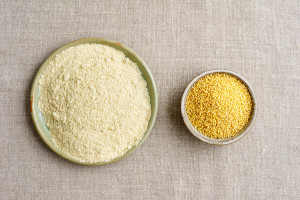 Millet flour is a smart carbohydrate with plenty of fiber, making it an excellent alternative to wheat flour. It has a relatively low glycemic index, and in contrast to grains such as wheat and rice it has been shown to produce lower blood sugar levels. It’s also low in allergenicity, making it a suitable wheat flour substitute for most of your guests.
Millet flour is a smart carbohydrate with plenty of fiber, making it an excellent alternative to wheat flour. It has a relatively low glycemic index, and in contrast to grains such as wheat and rice it has been shown to produce lower blood sugar levels. It’s also low in allergenicity, making it a suitable wheat flour substitute for most of your guests.
With almost 13 grams of protein per cup, millet flour is a good source of slow-burning energy. In terms of antioxidant minerals it offers copper, manganese, selenium (meeting about 70% of your daily needs), and zinc (meeting nearly 40%). It’s also a source of iron (26%), magnesium (44%), and about half of your daily requirements in vitamins B1, B3, and B6.
If that weren’t enough, millet flour act as a prebiotic. That means it feeds microflora in your stomach, and is very easy on your digestive system.
When baking, consider that millet flour has a very subtle but nutty flavor, and though it is sweet it has been known to work well both in sweet and savory dishes. If you’re after a delicate consistency you can use millet flour for its cake-like crumb. If, however, you’re after the added nutrition, feel free to replace up to 25% of the flour in your recipe with millet flour.
#21- Hemp Flour
If the last time you’ve considered hemp was during arts and crafts time at summer camp, it’s time to consider it again. 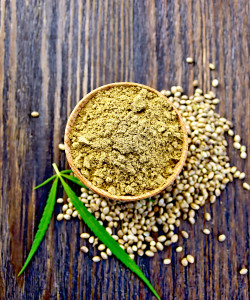 Far from the rough-to-the-touch necklaces of the 90s, hemp is actually a plant that has quite a lot to offer the health-conscious world.
Far from the rough-to-the-touch necklaces of the 90s, hemp is actually a plant that has quite a lot to offer the health-conscious world.
Hemp is actually just one of many sources for gluten-free flours, and it’s no surprise considered all that it has in nutritional value. Hemp flour has 40 grams of protein in each cup, including all 20 known amino acids. Nine of those essential amino acids are especially important, as they’re the only nine which our own bodies cannot produce on their own.
About 65% of the protein found in hemp flour comes from the globulin protein edestin, which aids digestion and is thought to be the backbone of the cell’s DNA. Hemp flour is 8% omega-3 fatty acids, with a 2:1 ratio of omega-6 to omega-3 fatty acids. It’s rich in gammalinoleic acid (GLA), as well as trace minerals and fiber.
When baking with hemp flour, be aware of how its high protein content affects the end result. You can reach a more desirable consistency by substituting only ¼ to ⅓ of your flour mix with hemp flour, making up the difference with wheat flour or gluten-free flours depending on your personal needs.
Hemp flour may not be for every baking recipe. As a very dense, granular flour, it doesn’t rise. You should also consider whether its nutty, earthy flavor is appropriate for your dish. At times it adds a plant-like flavor to your dish, though not always.
You can also enjoy hemp flour without cooking or baking it at all. It works well as a topping for soups, cereals, yogurt, or fruit, and it can be blended into smoothies. The easiest way to enjoy both the taste and nutritional value of hemp flour is to eat it plain, either alone or as just one ingredient in a homemade trail mix.
That’s it- that’s the list of the top 21 Gluten free Flours. There are others- but we will only be adding them to the list slowly over time now. Read up, ask questions (which our Registered Dietitians will answer) and if you find that a gluten free diet is the right choice for you, please drop by as we have lots of information to offer you on the Gluten Free Diet.
Have you seen our Gluten Free Flour Infographic? Click Here for a quick overview of 24 different Gluten Free Flours and their uses in your kitchen.
Continue your Weight Loss Education with this video
Comments 2
Leave a Reply
You must be logged in to post a comment.
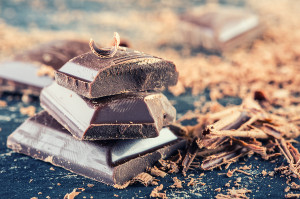



nice article
i love eating pure white corn flour that has no top layer.it just pure.